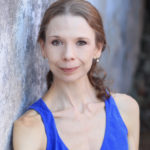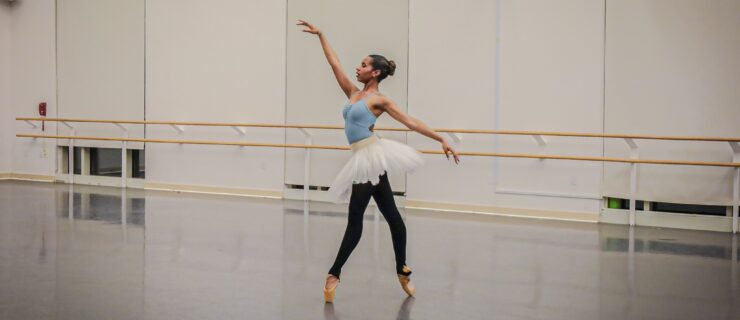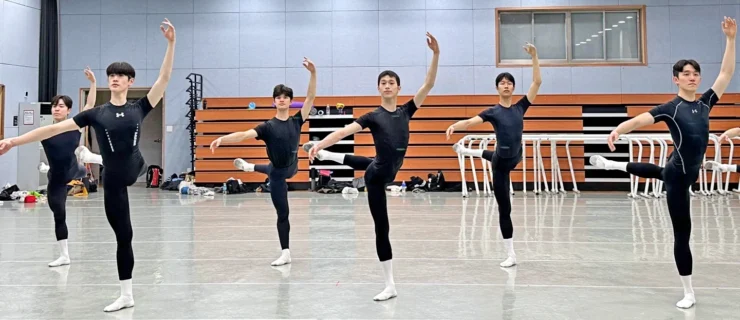Degrees of Success: These 3 Pros Are Thriving—And Have Their College Experiences to Thank
This story originally appeared in the October/November 2015 issue of
Pointe.
Today’s directors are increasingly looking for maturity, experience and versatility, and choreographers are drawn towards artistically intelligent dancers who can contribute to the creative process. Although ballet dancers have traditionally been wary of losing precious performing years by going to college before heading into the job market, it’s becoming routine to see company rosters populated with college grads. For these three professionals, the well-honed skills they gained in school not only boosted their dance careers, but opened doors into a myriad of exciting paths for their futures.
Elizabeth Walker, Los Angeles Ballet

Walker in The Moor’s Pavane. Photo by Reed Hutchinson, Courtesy LAB.
Elizabeth Walker always knew she’d go to college—it was just a question of when. Her senior year, she auditioned for companies and applied to schools, and was accepted to both Harvard University and Los Angeles Ballet. Luckily, Harvard allowed her to defer enrollment for a year and join LAB for its inaugural season.
While it was tough to leave LAB after only one year, Walker craved the opportunity to attend Harvard. “One of my goals was to expand my horizons and learn something else in depth,” she says. “I wanted to go somewhere and not be a dance major, but still be able to keep up my ballet.” There’s no formal dance department at Harvard, so Walker became heavily involved in its extracurricular program and student-run Harvard Ballet Company. A photography class she’d taken freshman year prompted her to major in art and architecture. “I’m fascinated by historical architecture and restoration.”
Life at Harvard, unsurprisingly, was hard. It was sometimes difficult for Walker to justify taking ballet every day, often taking open classes in studios around Boston, when she had so much academic work to do. But she wanted to keep her options open post-graduation. Juggling her extreme academic load with dance honed her skills in multitasking, time management and self-motivation, especially when she became co-artistic director of HBC. The experience was eye-opening: “You see everything that goes into putting a production together: marketing, hanging lights, selling tickets, choosing rep, casting. We even had to personally load in and load out of the theater.” And connections she made with visiting choreographers led to summer guesting gigs, both while at Harvard and post-graduation.
Walker loved the academic experience so much that she considered not resuming her ballet career. As a test, she took a semester off to rejoin LAB as a guest artist—and decided her commitment to dance was firm, signing a full-time contract after graduation. “I’m so glad to have done both. What I did at Harvard really informed who I became as a dancer, and being around people who are high achievers in any field is one of the best things you can do.” While she’s open to many possibilities after her performing career, her art and architecture degree will certainly inform her choices. “But I care so much about ballet and feel it needs to be preserved and promoted, so I might stay in the dance world.”
Tiffany Bovard, Louisville Ballet

Tiffany Bovard in rehearsal with Ballet Master Harald Uwe Kern. Photo by Renata Pavam, Courtesy Louisville Ballet.
Although she wanted to dance professionally, at 18, Tiffany Bovard didn’t feel ready to join a company. She’d received solid Russian-style training at her small studio in Virginia. But she lacked the experience of a pre-professional training setting, so she chose to enroll in Butler University’s ballet program. “I knew I would get a balance between academic life and dance training,” she says.
She was right. In addition to pursuing a BFA in dance performance, she minored in business. Summers working as a dorm director at a ballet intensive had highlighted her natural flair for organizing and management tasks, like scheduling and staff collaboration. “I realized how much I loved those aspects of a job, especially when it relates to something else I love, like dance,” she says. “I want to be an advocate for the arts, so working in a ballet company’s marketing or administrative department could be a good fit.”
With her eye still firmly on a dance career, though, Bovard soaked up her classes in ballet, modern, jazz and musical theater. And frequent performances of classical full-lengths and contemporary works in Butler’s 2,000-seat theater gave her experience akin to a professional dancer’s. The BFA students even toured to Europe to perform and take classes during summer breaks. And it paid off: After graduation, Bovard auditioned for Louisville Ballet, hoping the director would value her dancing as well as her degree.
Now, she feels grateful for her college career. “Dance-wise, I’m much more versatile,” she says. “Plus leadership, communication and decision-making skills, as well as knowing how people work within an organization, are all relevant in my current job.”
As for what’s next, Bovard is at ease about her future: “I absolutely feel more assured because of my non-dance education. Even though most of my job experience is as an artist, having the business minor will give me a leg up when I transition out of pointe shoes, and having the BFA stamped on top of my resumé will make me an appealing candidate to future employers.”
Melissa Anduiza, Complexions Contemporary Ballet

Anduiza and Pete Leo Walker in Reflections Of… Photo by Peter Zay, Courtesy Charlotte Ballet.
Melissa Anduiza’s intense pre-professional training at Miami’s New World School of the Arts had left her overwhelmed. Verging on burnout, she needed to rediscover her passion—and wanted a more balanced environment. On a teacher’s recommendation she turned to the University of South Florida, enrolling in its BFA program.
The university’s expectations were high. “There was an ethic of everyone wanting to do their best,” she says. “Not only did I study with world-class faculty like Bill T. Jones, I took kinesiology, production, dance history and pedagogy along with the core college requirements.” Her composition courses were particularly valuable, teaching her how to be choreographically creative within a structure, accept critique and make revisions. As Anduiza gained skills, her confidence grew. “I always wanted to dance, but never knew if I could do it until I went to USF,” she says. “My faculty told me I could go places, be somebody.” Bolstered by that support, she made up her mind to pursue a professional career.
Anduiza’s senior project, a solo she choreographed called “Stained Glass,” was awarded honors at the National College Dance Festival and performed at the festival’s Kennedy Center gala. She sent a video of her performance to Charlotte Ballet artistic director Jean-Pierre Bonnefoux, who offered her a job the day she graduated.
There, Anduiza’s choreographic talent was not overlooked. A dancer-run performance gave her the opportunity to create a duet on fellow dancers in 2012, and a solo she made the same year impressed Bonnefoux enough to add it to the company’s repertoire. Recently, she presented another work at the Southeastern Regional Ballet Association’s annual gala. While she’s mostly focused on dancing right now—she left Charlotte to join Complexions this summer—she’s ambitious about pursuing choreography in the future. She credits her confidence, skill and success in large part to her experience at USF. “An education creates versatile artists, and intelligent ones,” she says. “Dance is not a career to take lightly, and college is great professional preparation. I’m a living example of it!”








